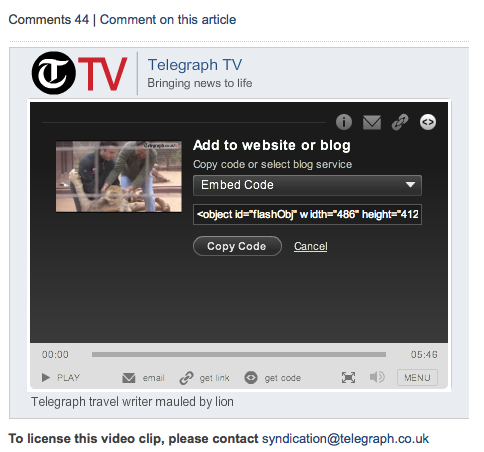It might look like you can embed this Telegraph video on your blog:

But no: please take note of the last part.
As both Journalism.co.uk and Fred Hatman, a journalist in South Africa found out, embed codes are only for ‘personal use’. That didn’t include Hatman (@fredhatman) even though he is a lone blogger.
Instead, we had to feature the story of the Telegraph journalist who was attacked by a lion after willingly entering its enclosure (mauling received surprisingly cheerfully) without the accompanying video. We got permission to link though!
Syndication@telegraph.co.uk informs us:
“I’m afraid at this time we can’t grant permission for you to host the video, but you are welcome to link to it.”
So we asked them why they supplied the code? And how could we fulfil the requirements for a licence? They replied:
“My understanding is that this function is for personal use only, not for commercial use, as per our terms and conditions. Often we are able to issue a licence for the content, but on this occasion Telegraph.co.uk are not offering this video for web syndication.”
Journalism.co.uk wonders how Telegraph.co.uk will monitor and police misuse of the videos – if abuse was extensive. Or how they decide who is commercial and who is not? If, as the Syndication people tell us, ‘on this occasion Telegraph.co.uk are not offering this video for web syndication’ why bother supplying it at all? Isn’t that just asking for trouble?
Thank you, Judith, for clarifying this issue. Very interesting. I think it raises a much wider issue about copyright on digital content.
It would be helpful if there were some universal guidelines on what is usable or embeddable for both “commercial sites” and “lone bloggers” such as myself, who is yet to earn a penny from my blog.
But, of course, how can the amorphous and open-to-all worldwideweb, transcending national borders, be regulated and, indeed, enforced.
It is confusing, however, when a large news organisation such as the Telegraph, for whom – somewhat ironically – I worked for six years – allows embedding of videos and then demands that hosting rights be applied for.
I would be interested to read the thoughts of other journalists, both traditional and digital, on this.
Thank you for your help, Fred Hatman
I would imagine the terms and conditions were written long before the Telegraph started using embeddable video. Now that the BBC have started syndicating their own video – with conditions attached – to the Telegraph and others it’s probably prompting many news sites to look at their own Ts & Cs.
Adding the ‘To license this video clip…’ text is a half-arsed stopgap measure.
As an industry we need to shake this issue out. Either it’s in an organisation’s interests to increase viewership of its video by allowing embedding – in which case it makes sense to allow it on commercial sites which typically have more users – or it isn’t. Time to choose.
Pingback: Footprints (15.09.09) | Chris Deary
Pingback: Bookmarks for August 25th through September 20th by andydickinson.net
Pingback: links for 2009-09-23 | Joanna Geary